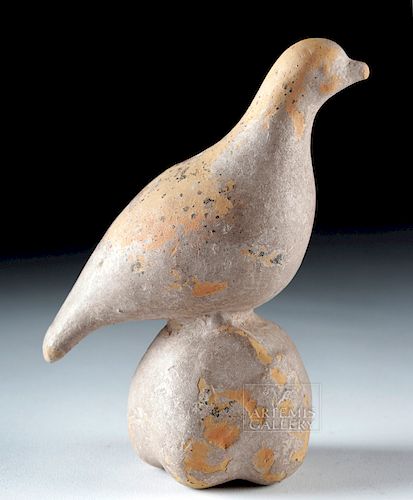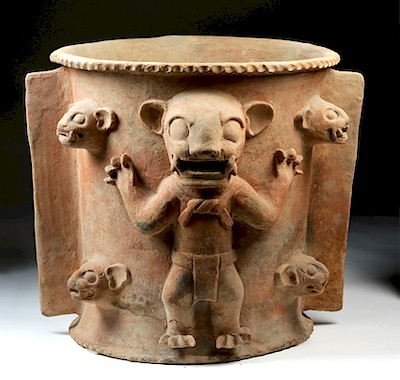Greek Canosan Pottery Dove Sitting Upon Pomegranate
Lot 23d
About Seller
Artemis Fine Arts
686 S Taylor Ave, Ste 106
Louisville, CO 80027
United States
Selling antiquities, ancient and ethnographic art online since 1993, Artemis Gallery specializes in Classical Antiquities (Egyptian, Greek, Roman, Near Eastern), Asian, Pre-Columbian, African / Tribal / Oceanographic art. Our extensive inventory includes pottery, stone, metal, wood, glass and textil...Read more
Estimate:
$800 - $1,200
Absentee vs Live bid
Two ways to bid:
- Leave a max absentee bid and the platform will bid on your behalf up to your maximum bid during the live auction.
- Bid live during the auction and your bids will be submitted real-time to the auctioneer.
Bid Increments
| Price | Bid Increment |
|---|---|
| $0 | $25 |
| $300 | $50 |
| $1,000 | $100 |
| $2,000 | $250 |
| $5,000 | $500 |
| $10,000 | $1,000 |
| $20,000 | $2,500 |
| $50,000 | $5,000 |
| $100,000 | $10,000 |
| $200,000 | $20,000 |
About Auction
By Artemis Fine Arts
Dec 6, 2018
Set Reminder
2018-12-06 10:00:00
2018-12-06 10:00:00
America/New_York
Bidsquare
Bidsquare : DAY 2 : Pre-Columbian, Ethnographic & Fine Art
https://www.bidsquare.com/auctions/artemis-gallery/day-2-pre-columbian-ethnographic-fine-art-3699
Day 2 of an important 2-dy auction featuring ancient and ethnographic art from around the world. Today's sale will feature Pre-Columbian, Native American, African / Tribal, Ethnographic, Spanish Colonial, Fine Art, much more. Artemis Fine Arts info@artemisfinearts.com
Day 2 of an important 2-dy auction featuring ancient and ethnographic art from around the world. Today's sale will feature Pre-Columbian, Native American, African / Tribal, Ethnographic, Spanish Colonial, Fine Art, much more. Artemis Fine Arts info@artemisfinearts.com
- Lot Description
Magna Graecia, Apulia, Canosan colonies, ca. 3rd century BCE. A delightful ceramic mold-made dove perched upon a pomegranate. Note the ample remains of pink pigment on the body. Given this, one can just imagine how lavishly painted the piece once was. Doves were incredibly popular in the classical world - for example, Pliny records a "mania" for the birds, with people constructing elaborate dovecotes (columbaria) atop their houses to keep the birds. The pomegranate, one of the earliest fruit species to be domesticated, was also an important symbol in ancient Greece. In Polykleitos' image of Hera in the Argive Heraion, she holds a scepter in one hand and a pomegranate in the other; Herodotus wrote of Persian soldiers carrying spears adorned with silver and gold pomegranates rather than spikes; Homer writes about them in the Odyssey. Perhaps the most famous story about pomegranates comes from the kidnap of Persephone by god of the Underworld Hades. See more about this in the extended description below. Size: 6.125" H (15.6 cm)
It was the rule of the Fates that anyone who consumed food or drink in the Underworld was doomed to spend eternity there, so Hades tricked Persephone into eating six pomegranate seeds, forcing her to remain in the Underworld for six months of the year. Following this, Pesephone's mother Demeter, the goddess of fertility, mourned Persephone during this period which became the more solemn autumn and winter months.
A Late Archaic terracotta dove on a pomegranate may be found in the collection of the Metropolitan Museum of Art (Accession Number 26.164.20) - https://www.metmuseum.org/art/collection/search/252584
Provenance: private East Coast, USA collection
All items legal to buy/sell under U.S. Statute covering cultural patrimony Code 2600, CHAPTER 14, and are guaranteed to be as described or your money back.
A Certificate of Authenticity will accompany all winning bids.
We ship worldwide and handle all shipping in-house for your convenience.
#142140Normal surface wear with pigment loss, though much pink pigment still graces the piece as shown. Mineral deposits grace the piece as well. Collection label on underside of pomegranate.Condition
- Shipping Info
-
All shipping is handled in-house for your convenience. Your invoice from Artemis Gallery will include shipping calculation instructions. If in doubt, please inquire BEFORE bidding for estimated shipping costs for individual items.
-
- Buyer's Premium



 EUR
EUR CAD
CAD AUD
AUD GBP
GBP MXN
MXN HKD
HKD CNY
CNY MYR
MYR SEK
SEK SGD
SGD CHF
CHF THB
THB
















